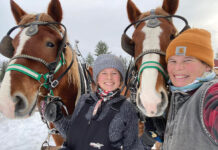Note: This is day 25 of my 30-day blogging challenge. What the heck is a 30-day blogging challenge? Read about it here.
His name is Cornet 39 and from what I could find, it appears he’s an Oldenburg who competed in Europe before coming to America. Here’s a video of him at the European Young Riders Championship.
He’s clearly a talented athlete, but there are lots of talented athletes at WEF. Let’s be honest: His color is what makes him remarkable. It’s not that you never see spots at high-level English discipline horse shows, but it’s pretty rare.
Horse color is a funny thing that way. On one end is the elite hunter/jumper and dressage world where it seems like everyone is riding a dark bay horse with minimal white markings. Other shades of bay, chestnut, black and gray show up to break the monotony. But a buckskin or pinto or anything else slightly exotic? Rarely. Good luck filling out your Horse Color Bingo card at one of these shows.
On the other end is the sort of color reverence you find among the lower-end horse classified listings. A horse could have its legs on backward and the personality of a swarm of angry hornets, but if it happens to be yellow or spotted, someone will be convinced that it’s a breeding prospect.
This is not to say that there’s some sort of color/conformation correlation. In the western world, there are lots of well-bred, talented buckskins, palominos, grullas and other non-bays, and judges don’t seem to have trouble rewarding talent that comes in a colorful package.

Palomino Yellow Jersey, shown here with Mandy McCutcheon, has been a successful reining horse at the international level.
What’s weird to me is that in a sport like show jumping, which is completely objective, you don’t see more color variety. Same with racing. There can’t be a judge’s color bias in the way when the judge is the clock. I suppose breeders are breeding for jumping (or racing) ability above all else, and so colors that are less represented in the gene pool aren’t going to grow unless they happen to be tied to a really talented athlete. Statistically, the standouts are more likely to be bay.
With dressage and hunters, I’m sure any judge will say that color doesn’t matter, but I have to wonder if on some subconscious level, it does. Maybe if Valegro happened to be palomino, he’d still be on top of the world. But for the more mid-level horses, I wouldn’t be surprised if not fitting the traditional mold hurt them a little.
Personally, I wish I could be colorblind, but if I’m at a show and a spotted or otherwise unusual-colored horse appears, I will gravitate to it. I might not like it best, but I’m probably going to watch it more than the bays and chestnuts around it. Even within the socially acceptable sport horse colors, I can’t deny my affinity for grays. I’m glad I don’t have to be the one to try to keep a gray show horse clean, mind you, but when I’m admiring other people’s horses, I’ll pick the grays every time.
Do any of you colorful-horse owners out there feel like your horse’s color has made a judge assess him differently from his competition, for better or worse? Tell me about it in the comments.
Back to The Near Side
Leslie Potter is Sr. Associate Web Editor of horseillustrated.com. Follow her on Twitter: @LeslieInLex.






I once got placed dead last in a pleasure class because the judge didn’t like the colour of my appy (varnish roan) a friend of mine who is a judge was watching the class said after that the horse that won (blood bay) started bucking in front of the judge.
I think the biggest thing to remember when you are riding a coloured Sporthorse is that you are going to stand out, good or bad. As you put it, your eye is drawn to the colour whether you like it or not. I show Hunters and had an Appaloosa previously and now a Pinto Canadian Sport Horse. I wouldn’t trade either of them for all the bay’s and chestnuts with Chrome in the world!
I have a white few spot Appaloosa mare and a black and white pinto mare and when I have shown them in hunters and dressage I have definitely noticed a bias under some judges (favorable and unfavorable). My white mare is already an established event Horse and my pinto is just moving up the levels to get to that point So it doesn’t bother me, but yes, definitely notice it.